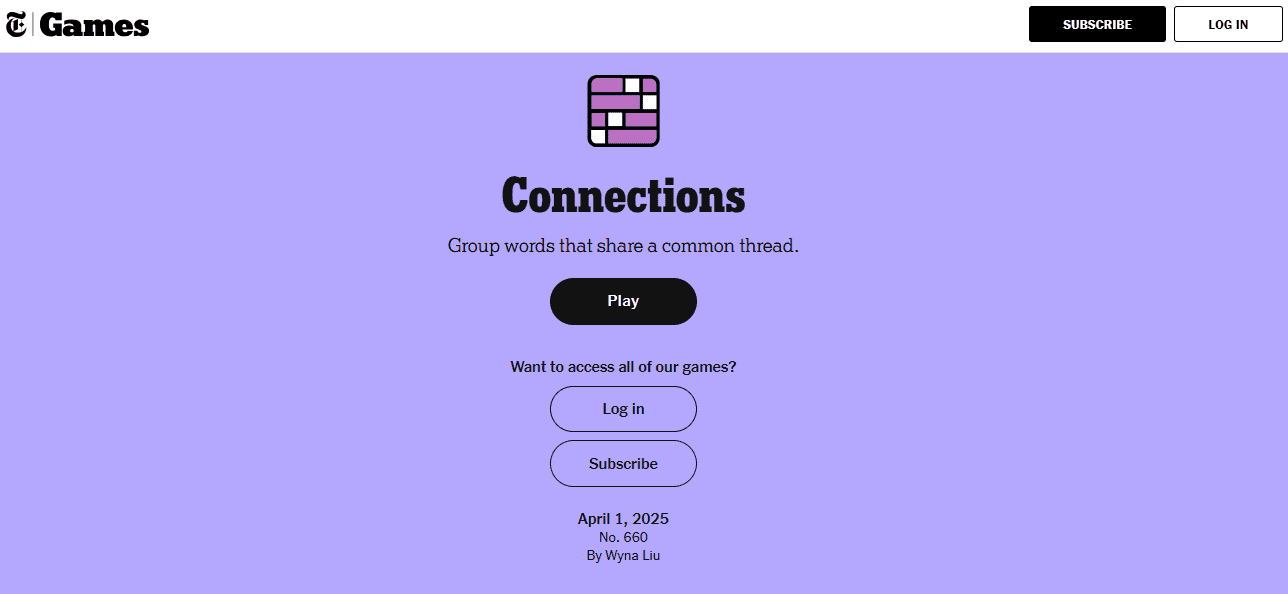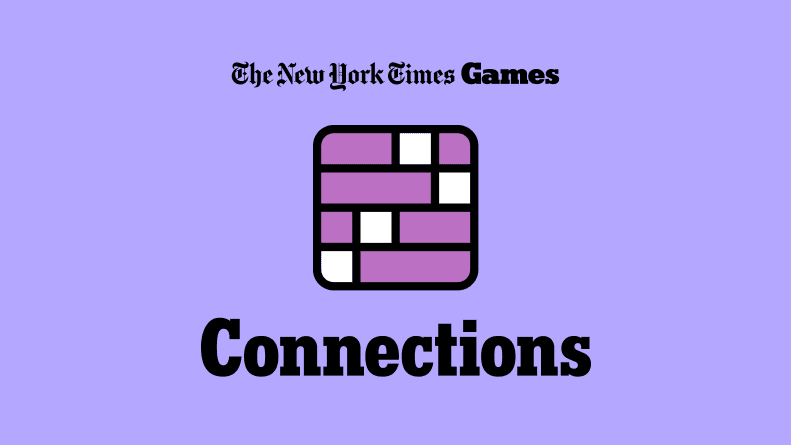NYT Connections is the New York Times’ daily word association puzzle that blends logic, language, and a bit of lateral thinking. It’s become a daily obsession for many puzzle fans, offering a fresh mental workout with each round. If you’re new to it or want to sharpen your strategy, here’s everything you need to know about how to play NYT Connections.
What Is NYT Connections?
Connections presents you with 16 words on a grid. Your goal is to group them into four sets of four, where each set shares a common theme or connection. The trick? Some connections are obvious—like four colors or four sports—but others are sneakily abstract or punny.

Each group is color-coded by difficulty:
- Yellow – Easiest
- Green – Medium
- Blue – Harder
- Purple – Tricky or obscure
How To Play Step-By-Step
- Open the Puzzle
Visit NYT Connections in your browser or through the NYT Games app. It refreshes daily at midnight local time. - Review All 16 Words
Take your time to read all the words. Start thinking about what could connect them—categories, meanings, or even wordplay. - Look for Obvious Groups First
Spot the most straightforward category (often yellow). It could be something like “days of the week” or “types of fruit.” - Select Four Words
Tap or click four words you think belong together. Hit “Submit” to check your guess. - Get Feedback
- If your guess is correct, those words will be removed from the board and labeled with their category.
- If it’s incorrect, you’ll be told how many of the four are right—but not which ones.
- Keep Going
Continue grouping until you’ve found all four sets or used up your four mistakes. After that, the puzzle ends and the full solution is revealed.
Tips and Strategy
- Start with themes, not words: Think about categories that often appear in puzzles—famous people, musical genres, brand names, homophones, etc.
- Look for duplicates or outliers: Sometimes a red herring will share a connection with more than four words. That’s a clue that the real group is more specific.
- Think beyond the obvious: Words might connect by function (verbs), spelling quirks, or pop culture references.
- Don’t rush: You’re not timed, so take your time making connections before committing.
Can You Replay NYT Connections?
Nope—once you complete (or fail) a puzzle, that day’s challenge is locked in. However, you can subscribe to NYT Games to access the archives, which include past Connections puzzles.
Why Is NYT Connections So Addictive?
Much like Wordle, the charm lies in its daily freshness and its balance of logic and surprise. Some days feel easy and satisfying; others are maddeningly clever. It’s also highly shareable—making it a perfect conversation starter among puzzle-loving friends.
Key Takeaways
- NYT Connections has demonstrated its lasting popularity among word game enthusiasts
- The New York Times recently added Connections statistics to their Games App for players to track progress
- Daily hints and answers are available online for players who need assistance with challenging puzzles
The Evolution of Nyconnections
Nyconnections has transformed from a simple word game to one of the most popular puzzles offered by The New York Times. The game’s growth reflects broader shifts in puzzle culture and digital entertainment.
Launching the Word Games Phenomenon
Nyconnections, commonly known as “Connections,” was released by The New York Times on June 12, 2023, initially in a beta phase. The game quickly gained popularity among word puzzle enthusiasts. According to search results, it has become the second-most-played game published by the Times, trailing only behind the viral sensation Wordle.
The game’s appeal lies in its simple concept with challenging execution. Players must sort 16 words into four groups of related terms. Unlike traditional crosswords, Connections requires players to identify thematic links between seemingly unrelated words.
The Times recently added statistics tracking in the NYT Games App, allowing players to monitor their progress and success rates over time.
From Traditional Crosswords to Nyconnections
The New York Times has long been known for its crossword puzzles, including the famous daily crossword and The Mini. However, the introduction of Connections represents the publication’s adaptation to changing puzzle preferences in the digital age.
While crosswords test vocabulary and general knowledge, Connections challenges players to identify patterns and relationships between words. This shift reflects a broader trend toward puzzles that test lateral thinking and pattern recognition.
The game’s digital format makes it accessible to a wider audience than traditional print puzzles. Players can enjoy Connections on various devices, expanding its reach beyond traditional newspaper subscribers.
The Times has recently launched an official Connections archive, giving players access to over 450 original puzzles from the game’s history.
The Role of Puzzle Editor in Word Gaming
Behind Nyconnections stands a team of puzzle editors who craft each day’s challenge. These editors balance difficulty with solvability, ensuring games are challenging but not impossible.
Puzzle editors must create groups that are thematically coherent while making sure words could potentially belong to multiple categories. This intentional ambiguity is what makes the game engaging.
Editors also monitor player statistics and feedback to refine puzzle difficulty. The game has evolved since its launch, with editors adjusting category types and difficulty based on player performance data.
The success of Connections demonstrates the crucial role of thoughtful editorial direction in word gaming. By creating puzzles that are both intellectually stimulating and entertaining, editors have helped establish Nyconnections as a daily ritual for many puzzle enthusiasts alongside The Mini and the traditional crossword.
Current Trends in Online Puzzles
Word puzzles have gained massive popularity in the digital space, with games like NYT Connections leading the charge. These puzzles combine traditional wordplay with modern technology to create engaging daily challenges for players worldwide.
Rising Popularity of Digital Puzzles
Word games like Connections have become daily habits for many puzzle enthusiasts. The New York Times has successfully capitalized on this trend by creating simple yet challenging puzzles that keep players coming back. Connections specifically asks players to find common threads between seemingly unrelated words.
Digital puzzles offer immediate feedback and satisfaction compared to traditional paper puzzles. They also allow developers to track user engagement and preferences, helping them refine and improve the gaming experience.
Many players appreciate how these puzzles provide mental stimulation in short, manageable sessions throughout their day.
Integrating Social Media with Puzzling
Social sharing has become a crucial element of online puzzling. Players often share their Connections results and stats with friends and followers, creating friendly competition.
The New York Times has embraced this social aspect by making it easy to share results without spoiling the puzzle for others. This social component has significantly contributed to the game’s viral spread.
Many players use dedicated hashtags to discuss strategies and commiserate over particularly challenging puzzles. Online communities on Reddit and Twitter have formed specifically around NYT Connections.
These social interactions extend the gaming experience beyond the puzzle itself, creating a sense of community among players. The shared experience of solving (or struggling with) the same daily puzzle creates common ground among diverse groups of people.
Connections Companion Apps and Bots
The NYT Games App now includes Connections stats tracking, allowing players to monitor their progress over time. This feature was recently added, reflecting the company’s commitment to enhancing the player experience.
Third-party companion websites have emerged to offer hints and solutions for players who get stuck. Sites like Word Finder and CNET regularly update with clues for the day’s puzzle.
These companion resources vary in how much help they provide. Some offer subtle hints preserving the challenge, while others provide complete solutions.
For competitive players, these stats tracking features add another dimension to the game. They can compare their solving patterns and success rates against their previous performances.
The development of these companion tools demonstrates the game’s significant impact and the ecosystem that has formed around it.
Cookie Usage in Gaming Platforms
Digital puzzle platforms like NYT Games collect user data through cookies to improve the gaming experience. This information helps developers understand how players interact with their puzzles.
Cookies allow for personalized gaming experiences, remembering a player’s progress and preferences across sessions. The New York Times uses this data for content measurement and audience research.
Many platforms offer settings that allow users to control cookie permissions. Players can often choose between essential cookies only or allow more extensive data collection.
This data collection also supports personalized advertising, helping to keep games financially viable while remaining free or affordable to players. Game developers must balance data collection with user privacy concerns.
Clear cookie policies have become increasingly important as players become more privacy-conscious. The most successful platforms maintain transparency about how player data is used.
Nyconnections Puzzle Mechanics
The Nyconnections puzzle presents players with a unique word-grouping challenge that tests vocabulary and pattern recognition skills. The game features a specific structure with color-coded difficulty levels and requires strategic thinking to master effectively.
Understanding Puzzle Structure and Difficulty
Nyconnections presents players with a 4×4 grid containing 16 unique words. The objective is to organize these words into four distinct groups of four, with each group sharing a common theme or connection. The puzzle uses a color-coded difficulty system to indicate challenge levels.
Yellow groups represent the easiest connections to spot, often featuring obvious relationships like animals or foods. Green connections are moderately challenging, while blue groups require deeper thinking. Purple groups are the most difficult, often involving wordplay, obscure references, or non-obvious connections.
Players must identify all four groupings correctly to solve the puzzle. Incorrect guesses result in strikes, with players limited to four strikes before failing the puzzle.
Categories and Groupings in Nyconnections
The puzzle’s groups can span numerous categories including:
- Common Objects: Items that share physical properties
- Cultural References: Words related to media, arts, or entertainment
- Word Patterns: Terms with similar prefixes, suffixes, or structures
- Conceptual Links: Words connected by abstract concepts
Each daily puzzle features a unique set of categories. For example, puzzle #650 (March 22, 2025) included groups related to compass directions, map elements, and other distinctive categories.
The connection between words isn’t always immediately apparent. Sometimes words can appear to fit multiple groups, requiring players to think creatively about alternative meanings or contexts.
Strategies to Enhance Vocabulary and Solve Rates
Successful players typically begin by scanning all 16 words before making connections. Look for the most obvious groupings first, usually the yellow category, to build momentum.
Effective tactics include:
- Testing multiple interpretations of words that could have several meanings
- Breaking down the remaining words after identifying one group
- Looking for linguistic patterns (prefixes, suffixes, phrases)
- Considering alternate definitions of familiar terms
When stuck, try organizing words into temporary test groups. This process often reveals connections you might have overlooked. Regular players gradually develop pattern recognition skills that improve solve rates over time.
Daily practice helps expand vocabulary and strengthens the ability to spot increasingly subtle connections between seemingly unrelated words.
Data Security and User Privacy
As online games like NY Connections gain popularity, protecting user information becomes increasingly important. Privacy concerns extend beyond gameplay to how websites track activity and manage personal data.
Protecting User Data in Online Games
NY Connections and similar games collect certain information to function properly. This may include IP addresses to authenticate users and prevent spam or abuse. Game developers implement various security measures to keep this information safe.
When players access these games through The New York Times website, their data falls under the site’s broader privacy policies. These typically include encryption protocols and secure servers.
Some games may use geolocation data to customize content or track statistics. Players should check privacy settings to understand what information is being collected during gameplay.
Recent incidents highlight the importance of data protection. A federal judge recently barred Social Security officials from sharing unredacted information, finding that scrutiny of agency data systems appeared to violate federal privacy laws.
The Importance of Cookie Management
Cookies are small files that websites store on users’ devices to remember preferences and track behavior. News sites like The New York Times use cookies to personalize content and advertisements.
Types of cookies used by news websites:
- Essential cookies (necessary for basic functions)
- Analytics cookies (track how users interact with content)
- Advertising cookies (create user profiles for targeted ads)
Managing these cookies gives users more control over their digital footprint. Most browsers allow users to view and delete cookies or block them entirely.
Regular cookie cleanup can improve privacy protection. Consider using browser extensions that automatically clear cookies after sessions or block trackers from collecting unnecessary information.
Consent and Privacy Settings for Users
Websites must now obtain clear consent before collecting personal data, especially in regions with strict privacy laws. This typically happens through consent banners or privacy notifications when first visiting a site.
Users should review privacy settings regularly:
- Check data collection permissions
- Review third-party access to personal information
- Adjust notification preferences
- Enable two-factor authentication when available
The New York Times and other major platforms provide privacy dashboards where users can manage their data. These controls allow users to limit what search data is stored and how long it’s retained.
Recent developments in privacy regulation have expanded user rights. Many platforms now offer options to download personal data or request its deletion entirely.
Engagement and Community Building
The NYT Connections puzzle has evolved beyond just a daily word game into a social phenomenon that brings people together. Players share strategies, celebrate victories, and commiserate over challenging puzzles across various platforms.
Creating a Community Around Puzzles
The New York Times has successfully fostered a vibrant community around its Connections puzzle. Since its beta launch on June 12 and official debut on the NYT Games app, players have formed strong bonds through shared experiences.
Forums dedicated to the puzzle allow users to discuss strategies and offer support. As one search result mentions, the daily Connections forum welcomes players to “give and receive puzzle — and emotional — support.”
Social media platforms have become hubs for Connections enthusiasts. Players post their color patterns (without revealing answers) to show their solving path, creating a sense of camaraderie.
The Times has implemented community-building initiatives specifically designed to enhance engagement beyond the core puzzle-solving experience.
Managing Spoilers and Sharing Answers
Spoiler etiquette has become an important aspect of the Connections community. Players have developed creative ways to discuss the puzzle without ruining it for others.
Many use color block patterns to share their solving journey without revealing specific words. This approach allows players to compare their performance while preserving the challenge for those who haven’t played yet.
The New York Times moderates its official forums to prevent outright spoilers, especially immediately after a new puzzle is released.
Some players wait until the following day to discuss the previous puzzle’s solutions, giving everyone a chance to solve independently. This considerate approach has helped maintain a positive community atmosphere.
Daily Challenges and User Retention
The daily nature of Connections creates a powerful retention mechanism for The New York Times. Players develop a habit of checking in daily, driving consistent traffic to NYT platforms.
The puzzle editor regularly introduces varying difficulty levels to keep players engaged. Some days feature more straightforward connections while others present mind-bending challenges that spark extensive community discussions.
Special themed puzzles occasionally coincide with holidays or current events, adding an element of surprise and topicality that enhances the daily experience.
As of March 2025, Connections continues to challenge players with fresh themes and word groupings. The March 19, 2025 puzzle particularly tested players’ word association skills according to search results.
The consistent difficulty curve helps retain both casual players and dedicated word puzzle enthusiasts over the long term.
Monetization and Advertising in Nyconnections
The New York Times has developed sophisticated monetization strategies for its digital games like Nyconnections. Their approach balances revenue generation with maintaining a positive user experience, which has contributed to their subscription growth.
Advertising Strategies for Online Games
The New York Times has carefully integrated advertising into its gaming ecosystem. According to recent reports, the Times is opening new targeting categories specifically for “superusers” and lifestyle content while deliberately avoiding politics and hard news in their game advertising spaces. This strategic separation helps maintain the enjoyable escape that games like Nyconnections provide.
The company utilizes non-intrusive ad placements that don’t disrupt gameplay. These include:
- Banner advertisements between game sessions
- Sponsored content that aligns with user interests
- Timed promotions during natural breaks in gameplay
This measured approach prevents ads from diminishing the gaming experience while still generating significant revenue. The Times reported an 8.8% increase in digital advertising revenue, partly attributed to their gaming platforms.
Balancing User Experience with Revenue Goals
The Times has found success by prioritizing user satisfaction while meeting financial targets. Their games like Nyconnections serve as both entertainment and subscription drivers.
This balancing act includes:
- Limited ad frequency to prevent user fatigue
- Premium subscription options that remove advertisements
- Value-added features for subscribers that enhance gameplay
The company’s subscription revenue grew 8.4% to $466.6 million in Q4, driven largely by digital-only products including games. This demonstrates how their user-first approach actually strengthens monetization potential rather than limiting it.
The Times maintains a “gaming first” mindset, recognizing that a positive experience leads to longer session times and greater user retention.
Analyzing Audience Data for Targeted Campaigns
The New York Times leverages sophisticated audience analysis to maximize advertising relevance. They collect data on user preferences and behaviors while respecting privacy concerns.
Using Cookie technology and first-party data, the Times creates detailed user profiles that help deliver Personalised Advertising without feeling intrusive. Their Audience Research indicates that gamers respond better to contextually relevant ads that match their interests outside of gaming.
The company partners with advertising platforms like Yahoo to expand their reach while maintaining control over ad quality. Their Content Measurement tools track engagement metrics to continuously refine targeting strategies.
This data-driven approach allows them to command premium rates from advertisers while serving users with more meaningful content. By understanding their audience deeply, the Times creates advertising that feels less like an interruption and more like a natural extension of the gaming experience.
Frequently Asked Questions
Players often have questions about accessing, playing, and mastering the New York Times Connections game. Here are answers to some common questions about this popular word puzzle game.
How to access the latest Connections game updates from the New York Times?
The New York Times Connections game updates daily with a new puzzle. Players can access it through the New York Times website or through the NYT Games App.
The puzzle typically refreshes at midnight Eastern Time each day, giving players a fresh challenge to solve. Recent updates have added Connections stats to the NYT Games App.
Are there any tips or hints available for solving the New York Times Connections puzzles?
Yes, hints are available for players who get stuck on particular puzzles. The New York Times provides official hints within the game itself.
Many websites and resources also offer daily hints for the current puzzle. These typically provide clues about the categories without giving away the entire solution.
Players can also look at the colors of the groups (yellow, green, blue, and purple) as they represent different difficulty levels, with yellow being the easiest and purple the most challenging.
What is the challenge level of the new Connections game compared to previous versions?
The New York Times Connections puzzles vary in difficulty from day to day. Some players report that newer puzzles have become more challenging as the game has evolved.
The difficulty often depends on how obscure the connections are between words. Purple connections are consistently the most difficult to identify.
Game designers have maintained a balance between accessibility for new players and sufficient challenge for experienced puzzle solvers.
How can players navigate changes in the New York Times Connections game?
Players should check the game regularly for interface updates or new features. The recent addition of Connections stats to the NYT Games App is an example of such changes.
Following the New York Times Games social media accounts can help players stay informed about updates or changes to the game. These official channels often announce new features.
When rule changes occur, the game typically provides on-screen guidance to help players adjust to the new mechanics.
Is there a subscription required to play the full version of the New York Times Connections?
Currently, the New York Times Connections game is available to play for free. Unlike some other NYT games, it does not require a subscription to access.
Players can enjoy the full version of the daily Connections puzzle without any paywall restrictions. This has contributed to its growing popularity.
The game’s availability may change in the future, as the New York Times occasionally adjusts which games require subscriptions.
What are the strategies for achieving high scores in the New York Times Connections game?
Starting with the most obvious connections can build momentum. Many players begin by identifying the yellow group, which is typically the most straightforward.
Looking for patterns in word types is helpful – connections might relate to synonyms, categories, phrases, or things that precede or follow another word.
Taking breaks when stuck can provide fresh perspective. Many successful players report that stepping away and returning later often helps them see connections they previously missed.






